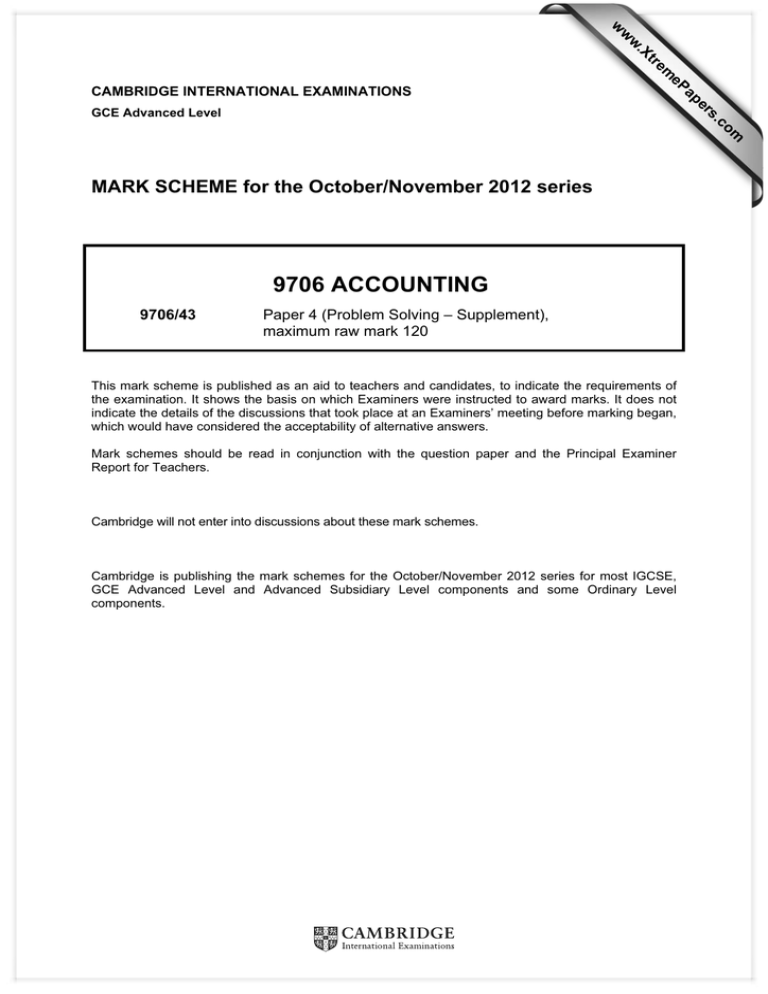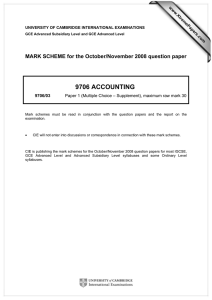9706 ACCOUNTING MARK SCHEME for the October/November 2012 series
advertisement

w
w
ap
eP
m
e
tr
.X
w
CAMBRIDGE INTERNATIONAL EXAMINATIONS
s
er
om
.c
GCE Advanced Level
MARK SCHEME for the October/November 2012 series
9706 ACCOUNTING
9706/43
Paper 4 (Problem Solving – Supplement),
maximum raw mark 120
This mark scheme is published as an aid to teachers and candidates, to indicate the requirements of
the examination. It shows the basis on which Examiners were instructed to award marks. It does not
indicate the details of the discussions that took place at an Examiners’ meeting before marking began,
which would have considered the acceptability of alternative answers.
Mark schemes should be read in conjunction with the question paper and the Principal Examiner
Report for Teachers.
Cambridge will not enter into discussions about these mark schemes.
Cambridge is publishing the mark schemes for the October/November 2012 series for most IGCSE,
GCE Advanced Level and Advanced Subsidiary Level components and some Ordinary Level
components.
Page 2
1
Mark Scheme
GCE A LEVEL – October/November 2012
(a) (i)
Syllabus
9706
Paper
43
Manufacturing account for the year ended 31 December 2011
$
$
31 000
Raw materials at 1 January 2011
Purchases
Carriage
261 000
2 500 1
Raw materials at 31 December 2011
Cost of raw materials consumed
Manufacturing wages
Direct expenses
166 000
9 200
}1
175 200
423 300 1 of
Prime cost
Supervisory wages
Factory rent
Depreciation of machinery
42 800 1
36 000 1
13 800 1
92 600
515 900 1 of
206 360 1 of
722 260 1 of
Production cost
Factory profit
Transfer cost
(ii)
263 500
294 500
46 400
248 100 1 of
[10]
Provision for unrealised profit
Balance c/d
24 800
4 Balance b/d
Income statement
24 800
Balance b/d
16 800
8 000
24 800
2
1 of
24 800
1 of
Working
722 260 1 of × 1 240 1 ÷ 10 318 1×
40 1
= 24 800
140
OR
515 900 1 of × 1240 1 ÷ 10 318 1 x
40 1
= 24 800
100
© Cambridge International Examinations 2012
[8]
Page 3
(iii)
Mark Scheme
GCE A LEVEL – October/November 2012
Syllabus
9706
Income statement for the year ended 31 December 2011
$
$
Sales
880 000
Finished goods at 1 January
2011
58 800
1
Transfer of finished goods
722 260
1 of
781 060
Finished goods at 31
December 2011
86 800
3 of
694 260
Gross profit
185 740
Factory profit
206 360
Office rent
21 000
1
Depreciation of office
equipment
2 900
1
Administrative and selling
costs
201 000
1
Increase in provision for
unrealised profit
8 000
1 of
232 900
Profit for the year
159 200
Paper
43
1 of
1 of
1 of
1 of
Working
722 260 1 of × 1240 1 ÷ 10 318 1 = 86 800
(b)
[13]
Statement of Financial Position at 31 December 2011
$
Non-current assets
Current assets
Inventory
Raw materials
Finished goods
Provision for
unrealised profit
Trade receivables
Bank
Current liabilities
Trade payables
46 400
$
570 000
1
86 800 1 of
24 800 1 of
62 000
108 400
96 200
11 000
215 600
1 all 3
(84 100)
Capital
Bal at 1 January 2011
Profit for the year
Drawings
(c)
131 500
701 500
622 300 1
159 200 1 of
(80 000) 1
701 500
Factory profit needs to be removed from items of inventory 1 because it
has not yet been earned/realised 1. This is an application of prudence 1.
[7]
[Max 2]
[Total: 40]
© Cambridge International Examinations 2012
Page 4
2
(a)
Mark Scheme
GCE A LEVEL – October/November 2012
Syllabus
9706
Paper
43
Statement of cash flows for Hyung Ltd for the year ended 31 March 2012
$000
Net loss for the year (15-30)
Depreciation
Loss on sale of non current assets
(240-108 = 132 1 – 30 1)
Increase in inventories
Increase in trade receivables
Decrease in trade payables
Net cash flow from operating activities
Investing activities
Payments to acquire fixed assets
Receipts from the sale of fixed assets
Financing activities
Issue of share capital (400 1+20 1)
Repayment of debentures
$000
(15) 1
236 1
102
(26)
(18)
(56)
223
1 of
2
2
2
1 of
(808) 1
30 1
(778) 1
420 1 of
(80) 1 of
Net decrease in cash and cash equivalents
Balance at 1 April 2011
Balance at 31 March 2012
340
(215)
174
(41)
1
1 of
1
1
[24]
(b)
(c)
Cash is the actual physical amount of money held by a business, whereas
profit is a calculated amount and does not represent actual money
Current ratio
198:93
2.13:1 1
Acid test
90:93
0.97:1 1
Return on capital employed =
(15)
x 100 = (0.83)% 1
1805
Return on equity =
(15)
x 100 = (0.89)% 1
1685
[2]
Max 4 marks for ratios
Hyung Ltd has a good liquidity position if inventories are included, however if
inventories are excluded then the business does not have enough current assets
to cover its current liabilities. Perhaps there has been too much spent on
inventories and non-current assets. 2
The business made a loss and therefore has a small negative return both on
capital employed and equity. 2
[8]
© Cambridge International Examinations 2012
Page 5
(d)
Mark Scheme
GCE A LEVEL – October/November 2012
Syllabus
9706
Paper
43
Loan – annual interest has to be paid out of profits before appropriations to the
shareholders. It may be secured on non current assets which cannot be sold for
the length of the loan. 3
Rights issue - usually the market price of the shares drops after a rights issue and
not all shareholders will chose to take up the rights so not all the desired money
will be raised. 3
[6]
[Total: 40]
3
(a)
$
30 000
37 500
5 000
1 500
2 000
750
1 000
77 750
÷ 1 250
= $62.20
1
1
1
1
1
1
1
1 of
1
1 of
$ per unit
24.00
30.00
4.00
1.20
1.60
0.60
0.80
62.20
2
2
1
1
1
1
1
1 of
Raw material
Direct labour
Direct costs
Supervisor
Rent
Maintenance
Fixed manufacturing costs
OR alternative
Raw material
Direct labour
Direct costs
Supervisor
Rent
Maintenance
Fixed manufacturing costs
(b)
Brought forward
Commission
Distribution
Administration
Mark-up (30%)
Selling price
$ per unit
62.20
2.50}
1.00}
8.20
73.90
22.17
96.07
(c)
1 of
1
1
1 of
1 of
1 of
$
Sales 1100 × 96.07 1 of
Manufacturing costs
Closing inventory
150 1 × 62.20 1 of
Gross profit
Shipping, commission and admin
1 100 × {1.00 + 2.50 + 8.2} 1
Profit from operations
[10]
[6]
$
105 677
77 750 1 of
(9 330)
1 of
68 420
37 257
1 of
12 870
24 387
© Cambridge International Examinations 2012
[7]
Page 6
(d)
Mark Scheme
GCE A LEVEL – October/November 2012
$22.17 1 of × 1100 1 = 24 387 1 of
(e)
Revenue (2000 ×136.5)
Variable costs (2000 ×70)
Fixed costs
Expected profit
(f)
(i)
Paper
43
[3]
$
273 000
140 000
70 000
63 000
2
[2]
63
= 23.08% 2 of
273
B/E =
(ii)
Syllabus
9706
7 00001
= 1053 units 1 of
66.5 1
(2 000 − 1 053) 1 of
= 47.35% 1 of
2 000 1 of
(iii)
(iv)
63
= 45% 2 of
140
63
= 90% 2 of
70
[12]
[Total: 40]
© Cambridge International Examinations 2012

